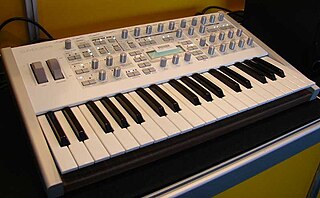Related Research Articles
Instrumentation is a collective term for measuring instruments that are used for indicating, measuring and recording physical quantities such as flow, temperature, level, distance, angle, or pressure. The term has its origins in the art and science of scientific instrument-making.

A keyboardist or keyboard player is a musician who plays keyboard instruments. Until the early 1960s musicians who played keyboards were generally classified as either pianists or organists. Since the mid-1960s, a plethora of new musical instruments with keyboards have come into common usage, requiring a more general term for a person who plays them. These keyboards include:
A distributed control system (DCS) is a computerised control system for a process or plant usually with many control loops, in which autonomous controllers are distributed throughout the system, but there is no central operator supervisory control. This is in contrast to systems that use centralized controllers; either discrete controllers located at a central control room or within a central computer. The DCS concept increases reliability and reduces installation costs by localising control functions near the process plant, with remote monitoring and supervision.

PROFIBUS is a standard for fieldbus communication in automation technology and was first promoted in 1989 by BMBF and then used by Siemens. It should not be confused with the PROFINET standard for Industrial Ethernet. PROFIBUS is openly published as part of IEC 61158.

Emerson Electric Co. is an American multinational corporation headquartered in Ferguson, Missouri, United States. This Fortune 500 company manufactures products and provides engineering services for a wide range of industrial, commercial, and consumer markets. Emerson has approximately 76,500 employees and 205 manufacturing locations worldwide.
RS-485, also known as TIA-485(-A) or EIA-485, is a standard defining the electrical characteristics of drivers and receivers for use in serial communications systems. Electrical signaling is balanced, and multipoint systems are supported. The standard is jointly published by the Telecommunications Industry Association and Electronic Industries Alliance (TIA/EIA). Digital communications networks implementing the standard can be used effectively over long distances and in electrically noisy environments. Multiple receivers may be connected to such a network in a linear, multidrop bus. These characteristics make RS-485 useful in industrial control systems and similar applications.
Fieldbus is the name of a family of industrial computer network protocols used for real-time distributed control, standardized as IEC 61158.
A digital asset, in essence, is anything that exists in a binary format and comes with the right to use. Data that do not possess that right are not considered assets. Digital assets include but are not exclusive to: digital documents, audible content, motion picture, and other relevant digital data that are currently in circulation or are, or will be stored on digital appliances such as: personal computers, laptops, portable media players, tablets, storage devices, telecommunication devices, and any and all apparatuses which are, or will be in existence once technology progresses to accommodate for the conception of new modalities which would be able to carry digital assets; notwithstanding the proprietorship of the physical device onto which the digital asset is located.
Fieldbus Foundation was an organization dedicated to a single international, interoperable fieldbus standard. It was established in September 1994 by a merger of WorldFIP North America and the Interoperable Systems Project (ISP). Fieldbus Foundation was a not-for-profit trade consortium that consisted of more than 350 of the world's suppliers and end users of process control and manufacturing automation products. Working together those companies made contributions to the IEC/ISA/FDI and other fieldbus standards development.
Foundation Fieldbus is an all-digital, serial, two-way communications system that serves as the base-level network in a plant or factory automation environment. It is an open architecture, developed and administered by FieldComm Group.

Profinet is an industry technical standard for data communication over Industrial Ethernet, designed for collecting data from, and controlling equipment in industrial systems, with a particular strength in delivering data under tight time constraints. The standard is maintained and supported by PROFIBUS & PROFINET International (PI), an umbrella organization headquartered in Karlsruhe, Germany.
Asset management refers to systematic approach to the governance and realization of value from the things that a group or entity is responsible for, over their whole life cycles. It may apply both to tangible assets and to intangible assets. Asset management is a systematic process of developing, operating, maintaining, upgrading, and disposing of assets in the most cost-effective manner.
Industrial control system (ICS) is a general term that encompasses several types of control systems and associated instrumentation used for industrial process control.
A control valve is a valve used to control fluid flow by varying the size of the flow passage as directed by a signal from a controller. This enables the direct control of flow rate and the consequential control of process quantities such as pressure, temperature, and liquid level.
Mimic Simulation Software is a simulation software developed by MYNAH Technologies that allows modeling of process plant unit operations. Mimic supports simulation of Foundation Fieldbus, ProfibusDP, DeviceNet, As-I Bus and HART smart field devices. Process industries using Mimic include hydrocarbon production, refining, petrochemical, specialty chemical, life sciences, food and beverage, pulp and paper, mineral production, and industrial energy.
Mobile enterprise asset management refers to the mobile extension of work processes for maintenance, operations and repair of corporate or public-entity physical assets, equipment, buildings and grounds. It involves management of work orders via communication between a mobilized workforce and computer systems to maintain an organization's facilities, structures and other assets.
Device Description Language (DDL) is the formal language describing the service and configuration of field devices for process and factory automation.
References
- ↑ Plant Asset Management Archived August 28, 2009, at the Wayback Machine ARC Advisory Group.